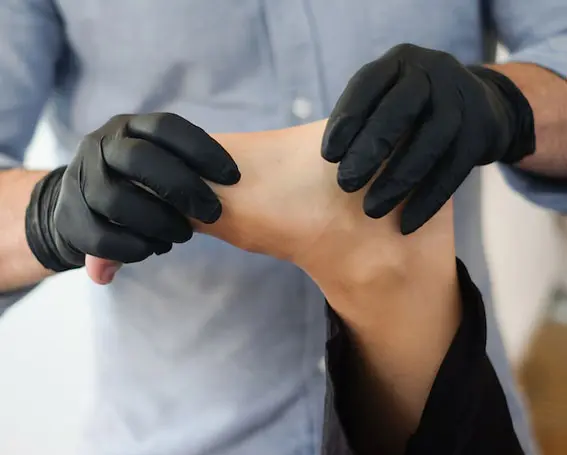Ankle Pain and Instability Treatment
Ankle pain and instability can be debilitating. What might seem like minor pain to your doctor can significantly impact your life; you may not be able to play soccer with your grandkids or participate in your weekly basketball game or tennis match. You might be unable to stay on your feet during your required shift or take your dog for a much-needed run at the end of the day.
Foot & Ankle Center is the region’s go-to ankle and foot center because they understand the considerable effects ankle pain can have on your quality of life. Look no further for an ankle doctor who will treat your condition thoughtfully and thoroughly, whether it’s your first sprain from after school sports or your one-hundredth pro sports injury.
Why Does Ankle Pain Happen?
Ankle pain typically occurs because of ankle instability or developing arthritis. You have supporting ligaments and muscles around all of your joints, and when they are weak, overstretched, or torn, your joint is left unsupported and vulnerable. Ineffective joint stabilization can lead to wearing down the cartilage in your joint, which is the essential shock absorber and cushion for your joints. Be aware that infections and autoimmune diseases can trigger arthritis in addition to injury and trauma.

What Causes Ankle Instability?
Ankle instability typically is a symptom or result of some other condition. Whether it’s a structural abnormality, a health condition affecting the nerves in your feet and legs, a poorly recovered ankle sprain, or a combination of all these, the ankle pain you are dealing with didn’t develop overnight.
Here are several contributing factors to your ankle instability:
- Age:
As you get older, your ligaments and muscles can lose tone and weaken, especially if you slow down or have lifestyle changes like reduced activity due to retirement. The lack of support from connective tissue can lead to ankle pain and instability. - Ankle Sprains
While a sprain may be minor at the time, it can lead to ankle pain down the road. When you suffer a sprain, you have either stretched or torn the ligaments that help stabilize your ankle joint. This can make it less stable and more prone to future sprains. They can develop into chronic ankle instability or pain if not treated properly. - Other Injuries and Overuse
If you have a weakness or injury to your calf muscle, one of the supporting muscles for your ankle, you can have more stress on your ankle. Now suppose you heighten the problem by playing sports or participating in a physically demanding job with repetitive ankle movements. In that case, you are putting more strain on your ligaments, resulting in avoidable injuries and long-term ankle instability. - Congenital Conditions
Hypermobility is one of the most significant conditions impacting your ankle instability. If you are born with hypermobile joints or joint laxity, you are more prone to joint pain. If your hip, knee, or ankle joints are naturally loose, you can suffer instability and need an ankle pain cure. And there are other congenital problems that can cause you to need an ankle doctor, including high arches, flat feet, or other joint abnormalities. These can all lead to ankle pain and instability. - Other Health Conditions
Neuromuscular conditions such as cerebral palsy, peripheral neuropathy, or multiple sclerosis can affect the nerves surrounding your joints for muscle control and pain reception, resulting in ankle instability over time.
Will Ankle Pain or Ankle Instability Resolve Itself?
In minor cases like your initial sprain or strain, it may resolve independently, especially with the help of the acronym RICE; rest, ice, compression, and elevation. However, this doesn’t repair the damage to your ligaments. That’s why one sprain frequently leads to more injuries and chronic instability over time.
When performing activities that could strain your ankle, make sure to support it with external reinforcements like braces or kinesiology tape. You should also strengthen the supportive muscles around your ankle and its range of motion with exercises. In moderate cases, you may require physical therapy to help. In extreme cases, you may need surgery to repair the damaged ligaments.


When Should I See An Ankle Doctor?
Depending on the reason for your ankle pain, there are different guidelines for when to see a doctor. When in doubt, always get checked out, but here are some of the main reasons you should seek help from an ankle doctor:
- You are practicing RICE and still experiencing ankle pain after the two to four weeks it takes for a minor sprain to heal.
- You are experiencing extreme pain that isn’t relieved by over-the-counter pain medication or ice at any point.
- You have a history of ankle injuries and are experiencing joint tenderness, swelling, or stiffness.
- You are frequently spraining or injuring your ankles.
- You are unable to put weight on your ankle.
- Your ankle’s symptoms are interfering with your daily activities.
When you ignore symptoms for too long, you can develop arthritis and require ankle arthritis treatment. Always have a doctor assess your pain to prevent long-term injuries, joint degradation, and ankle instability.
Why Choose Foot and Ankle Center for Ankle Instability Treatment?
With any joint weakness or instability, a single appointment won’t cure your ankle pain. Foot & Ankle Center has multiple ankle and foot centers across the state of Nevada to be convenient for your follow-ups, whether you visit the office closest to your work or home. If you happen to move, you may be able to continue treatment with your same team, which is often impossible in this specialty.
Dr. Cameron earned his doctorate in podiatric medicine. After completing his residency, he opted to complete an additional 3-year surgical residency for ankle reconstruction.
Despite his surgical training, he believes surgery is invasive and should be a last resort. Dr. Cameron starts with the most conservative, viable treatment, creating a unique and personalized treatment plan for you and your lifestyle. He trained to treat various foot and ankle conditions, so he can implement interventions that will not only help your primary complaint but also help the contributing factors that other specialty foot surgeons may overlook.
Because Dr. Cameron suffered a congenital foot ailment and subsequent treatment, he’s been in your position and can empathize. He will treat you as a whole patient and not just your condition, which is what you want when selecting your ankle doctor.

